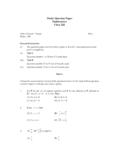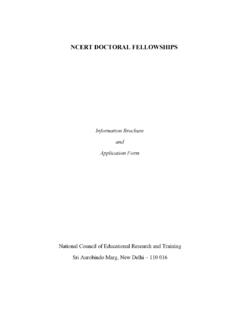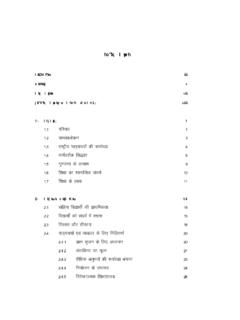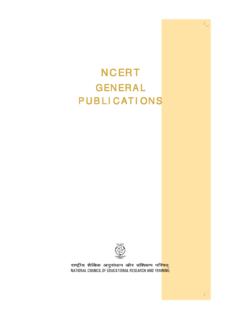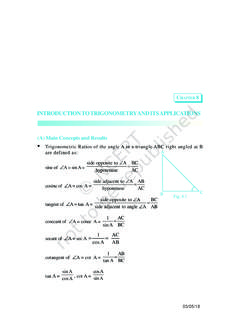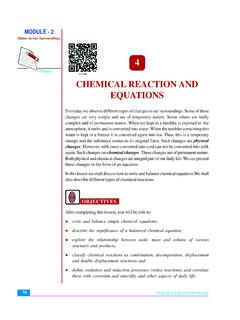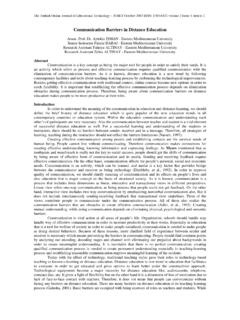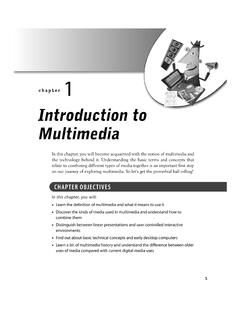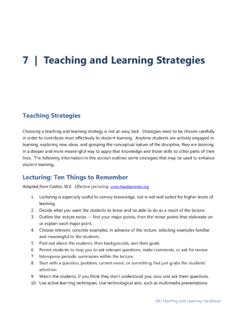Transcription of Martin H. Fischer CHAPTER1 Chemical Reactions and ... - NCERT
1 Chemical Reactionsand Equations1 CHAPTERC onsider the following situations of daily life and think what happenswhen milk is left at room temperature during summers. an iron tawa/pan/nail is left exposed to humid atmosphere . grapes get fermented. food is cooked. food gets digested in our body. we all the above situations, the nature and the identity of the initialsubstance have somewhat changed. We have already learnt about physicaland Chemical changes of matter in our previous classes. Whenever a chemicalchange occurs, we can say that a Chemical reaction has taken may perhaps be wondering as to what is actually meant by achemical reaction. How do we come to know that a Chemical reactionhas taken place?
2 Let us perform some activities to find the answer tothese of a magnesium ribbon in air and collection of magnesiumoxide in a watch-glassActivity : This Activity needsthe teacher s assistance. Itwould be better if studentswear eye protection. Clean a magnesium ribbonabout 2 cm long by rubbingit with sandpaper. Hold it with a pair of it using a spirit lamp orburner and collect the ash soformed in a watch-glass asshown in Fig. Burn themagnesium ribbon keeping itas far as possible from youreyes. What do you observe? Facts are not science as the dictionary is not literature. Martin H. FischerScience2 Activity of hydrogengas by the action ofdilute sulphuric acid onzincFrom the above three activities, we can say that any ofthe following observations helps us to determine whethera Chemical reaction has taken place change in state change in colour evolution of a gas change in we observe the changes around us, we can seethat there is a large variety of Chemical Reactions takingplace around us.
3 We will study about the various typesof Chemical Reactions and their symbolic representationin this Take a few zinc granules in a conical flask or a test tube. Add dilute hydrochloric acid or sulphuric acid to this(Fig. ).CAUTION: Handle the acid with care. Do you observe anything happening around the zincgranules? Touch the conical flask or test tube. Is there any change inits temperature? Take lead nitratesolution in a testtube. Add potassiumiodide solutionto this. What do youobserve? Chemical EQUAAL EQUAAL EQUAAL EQUAAL EQUATIONSTIONSTIONSTIONSTIONSA ctivity can be described as when a magnesium ribbon is burnt inoxygen, it gets converted to magnesium oxide.
4 This description of achemical reaction in a sentence form is quite long. It can be written in ashorter form. The simplest way to do this is to write it in the form of word-equation for the above reaction would be Magnesium + Oxygen Magnesium oxide( ) (Reactants)(Product)The substances that undergo Chemical change in the reaction ( ),magnesium and oxygen, are the reactants. The new substance,magnesium oxide, formed during the reaction, is the word-equation shows change of reactants to products through anarrow placed between them. The reactants are written on the left-handside (LHS) with a plus sign (+) between them. Similarly, products arewritten on the right-hand side (RHS) with a plus sign (+) between arrowhead points towards the products, and shows the direction ofthe must have observed that magnesium ribbon burns with adazzling white flame and changes into a white powder.
5 This powder ismagnesium oxide. It is formed due to the reaction between magnesiumand oxygen present in the Reactions and Writing a Chemical EquationIs there any other shorter way for representing Chemical equations? Chemical equations can be made more concise and useful if we usechemical formulae instead of words. A Chemical equation represents achemical reaction. If you recall formulae of magnesium, oxygen andmagnesium oxide, the above word-equation can be written as Mg + O2 MgO( )Count and compare the number of atoms of each element on theLHS and RHS of the arrow. Is the number of atoms of each element thesame on both the sides? If not, then the equation is unbalanced becausethe mass is not the same on both sides of the equation.
6 Such a chemicalequation is a skeletal Chemical equation for a reaction. Equation ( ) isa skeletal Chemical equation for the burning of magnesium in Balanced Chemical EquationsRecall the law of conservation of mass that you studied in Class IX; masscan neither be created nor destroyed in a Chemical reaction. That is, thetotal mass of the elements present in the products of a Chemical reactionhas to be equal to the total mass of the elements present in the other words, the number of atoms of each element remains thesame, before and after a Chemical reaction. Hence, we need to balance askeletal Chemical equation. Is the Chemical Eq. ( ) balanced? Let uslearn about balancing a Chemical equation step by word-equation for Activity may be represented as Zinc + Sulphuric acid Zinc sulphate + HydrogenThe above word-equation may be represented by the followingchemical equation Zn + H2SO4 ZnSO4 + H2( )Let us examine the number of atoms of different elements on bothsides of the of atoms inNumber of atomsreactants (LHS)in products (RHS)Zn11H22S11O44As the number of atoms of each element is the same on both sides ofthe arrow, Eq.
7 ( ) is a balanced Chemical us try to balance the following Chemical equation Fe + H2O Fe3O4 + H2( )Science4 Step I: To balance a Chemical equation, first draw boxes around eachformula. Do not change anything inside the boxes while balancing + H2O Fe3O4 + H2( )Step II: List the number of atoms of different elements present in theunbalanced equation ( ).ElementNumber of atomsNumber of atomsin reactants (LHS)in products (RHS)Fe13H2 2O1 4To equalise the number of atoms, it must be remembered that wecannot alter the formulae of the compounds or elements involved in thereactions. For example, to balance oxygen atoms we can put coefficient 4 as 4 H2O and not H2O4 or (H2O)4. Now the partly balanced equationbecomes Fe + 4 H2O Fe3O4 + H2 Step IV: Fe and H atoms are still not balanced.
8 Pick any of these elementsto proceed further. Let us balance hydrogen atoms in the partly equalise the number of H atoms, make the number of moleculesof hydrogen as four on the III: It is often convenient to start balancing with the compoundthat contains the maximum number of atoms. It may be a reactant or aproduct. In that compound, select the element which has the maximumnumber of atoms. Using these criteria, we select Fe3O4 and the elementoxygen in it. There are four oxygen atoms on the RHS and only one onthe balance the oxygen atoms The equation would be Fe + 4 H2O Fe3O4 + 4 H2 Atoms ofIn reactantsIn productsoxygen(i) Initial1 (in H2O)4 (in Fe3O4)(ii) To balance1 44 Atoms ofIn reactantsIn productshydrogen(i) Initial8 (in 4 H2O)2 (in H2)(ii) To balance82 4( )(partly balanced equation)( )(partly balanced equation) Chemical Reactions and Equations5To equalise Fe, we take three atoms of Fe on the Fe + 4 H2O Fe3O4 + 4 H2( )Step VI.
9 Finally, to check the correctness of the balanced equation, wecount atoms of each element on both sides of the + 4H2O Fe3O4 + 4H2 The numbers of atoms of elements on both sides of Eq. ( ) areequal. This equation is now balanced. This method of balancing chemicalequations is called hit-and-trial method as we make trials to balancethe equation by using the smallest whole number VII: Writing Symbols of Physical States Carefully examinethe above balanced Eq. ( ). Does this equation tell us anything aboutthe physical state of each reactant and product? No information hasbeen given in this equation about their physical make a Chemical equation more informative, the physical statesof the reactants and products are mentioned along with their chemicalformulae.
10 The gaseous, liquid, aqueous and solid states of reactantsand products are represented by the notations (g), (l), (aq) and (s),respectively. The word aqueous (aq) is written if the reactant or productis present as a solution in balanced Eq. ( ) becomes3Fe(s) + 4H2O(g) Fe3O4(s) + 4H2(g)( )Note that the symbol (g) is used with H2O to indicate that in thisreaction water is used in the form of physical states are not included in a Chemical equation unlessit is necessary to specify the reaction conditions, such as temperature, pressure,catalyst, etc., for the reaction are indicated above and/or below the arrowin the equation. For example CO(g) + 2H (g)2340 atmCH OH(l)3 ( )6CO (aq) 12H O(l)C H O (aq) 6O226126++SunlightChlorophyll 222(aq) 6H O(l)+( ) (Glucose)Using these steps, can you balance Eq.
